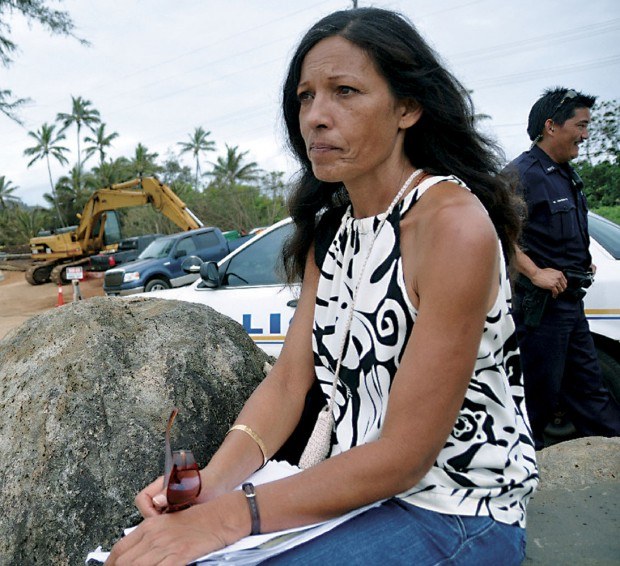LIHU‘E — Fifth Circuit Judge Kathleen Watanabe on Tuesday dismissed a citizen challenge of the planned widening of Kuhio Highway in Wailua.
Waldeen K. Palmeira of Wailua argued state and federal authorities failed to follow their rules regarding consulting Native Hawaiian cultural practitioners before allowing the project to go forward, and that she is sure ancient Hawaiian burials exist along the road-widening route.
Watanabe said that without testimony from witnesses who have knowledge of the suspected burials, she had no choice but to grant the state Department of Transportation’s motion for summary judgment, effectively giving the project the green light to proceed and ending the legal matter unless Palmeira appeals the decision.
Palmeira and the Native Hawaiian Legal Corporation had sought a preliminary injunction and summary judgment in October 2009, saying an environmental impact statement is necessary before the project should be allowed to proceed.
The state motions were to dismiss the lawsuit for lack of merit or, in the alternative, to grant summary judgment in favor of the state, either of which would effectively allow the project to proceed.
The $33 million project is planned to widen Kuhio Highway to four lanes from Kuamo‘o Road to the Kapa‘a bypass road, using federal funds that will lapse if not encumbered by Sept. 30, the end of the federal fiscal year, said William Wynhoff, state deputy attorney general representing DOT.
Palmeira asked for a continuance of the Tuesday hearing, citing her own health issues, but Watanabe denied that last-minute motion, Wynhoff objecting to the motion saying even another one-month delay would likely kill the project.
At the April hearing on the matter Palmeira fired her NHLC attorneys, and on Tuesday struggled to make her case without legal representation.
She requested the continuance to find new representation and because of her health issues.
Wynhoff said the narrow area to be used for the road-widening has already been “fully developed,” and Palmeira’s assertion that the road would be built over a graveyard “is just not so.”
“If we do find bones they’re going to be treated sensitively,” he said. “We might encounter some bones.”
Because the project is adjacent to one of the island’s busiest highways, it is not expected to significantly affect any traditional cultural practices or important cultural areas, said Wynhoff.
Palmeira disagreed, saying the area is the richest cultural and political center on the island, has been for 200 years, and is home to the only known named burial site, a place that translates from Hawaiian as “burials in the sand.”
Palmeira said that site extends from the fishponds at the old Coco Palms Resort to the ocean at Wailua Beach.
“The state is breaking the law on this one,” she said, adding that the shallow depth of the archaeological excavations conducted for the state by Cultural Surveys Hawai‘i failed to discover any human remains, known as “iwi kupuna.”
“They did not look good enough. I feel the entire process has been wrong,” Palmeira said.
Watanabe, who like Wynhoff patiently waited during most of Palmeira’s pauses due to her unfamiliarity with the pleadings bearing her name, finally scolded Palmeira for her rudeness for interrupting both Wynhoff and Watanabe repeatedly during the proceedings.
Watanabe said there was a “clear disconnect” between the written filings and Palmeira’s oral arguments, and that the state has conducted a thorough investigation across the narrow project corridor that has been a transportation route for vehicles including trains for over a century.
Use of ground-penetrating radar and other technologies revealed no bones, and neither did an environmental assessment, Watanabe said.
There are six undisputed facts which led to Watanabe’s decisions, she said:
— Summary judgment is allowed based on the facts and factors of the case;
— The state Department of Land and Natural Resources’ State Historic Preservation Division has jurisdiction over inadvertent discoveries of Native Hawaiian human remains;
— The Kaua‘i Ni‘ihau Island Burial Council has jurisdiction over known burial remains;
— The state has strict rules where graves are concerned;
— There are no known burial sites or remains in the project site, though some may be discovered during construction;
— Palmeira lacks any specific knowledge of graves in the project site, but two people Palmeira said have knowledge of graves in the project site were not present in court Tuesday and are not named or referenced in any of Palmeira’s pleadings.
If burials are discovered during construction, state laws will be followed for disposition of bones, said Watanabe.
“I do sympathize with Ms. Palmeira and what she’s trying to do, but the court has to act on matters of law,” said Watanabe, adding after making her rulings that Palmeira should work with the state Legislature to toughen burial-discovery laws.
Brennon Morioka, DOT director, has repeatedly said state officials felt the suit was without merit. DOT has met all state statutory requirements for proceeding with the project, he has said, and information contained in the state EA shows all necessary due diligence was done and statutory requirements met.
• Paul C. Curtis, assistant editor and staff writer, can be reached at 245-3681 (ext. 224) or pcurtis@kauaipubco.com.


